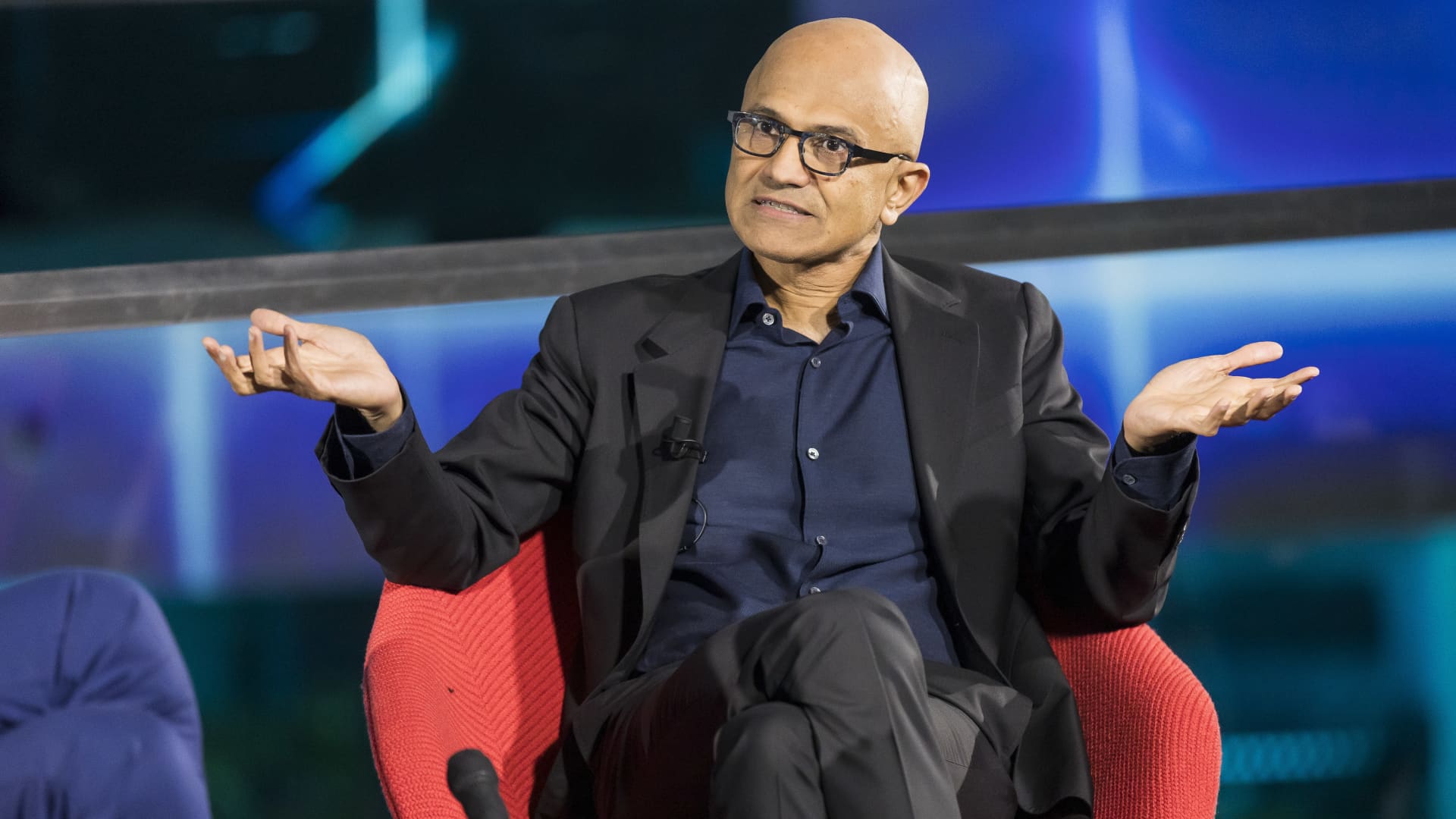Microsoft shares fell in extended trading on Wednesday despite the tech giant reporting a pretty clean beat across nearly every metric. Blame lofty investor expectations after a blowout report three months ago. Revenue increased about 18% year over year to $77.64 billion in its first quarter of fiscal 2026, beating the Street consensus estimate of $75.3 billion, according to data from LSEG. Earnings per share increased 13% from last year to $3.72, ahead of EPS estimates of $3.67, LSEG data showed. On a non-GAAP basis, which excludes losses from investments in OpenAI, adjusted EPS was $4.13. That was a 41-cent hit. Microsoft Why we own it : Microsoft is a core backbone of global productivity thanks to its Office 365 suite and hybrid cloud platform Azure. The company is also proving itself to be a key provider of artificial intelligence tools due, in part, to its large investment in OpenAI, the startup behind ChatGPT. We also like what it’s doing in the video gaming industry as it looks to grow recurring revenue streams. Competitors : Amazon , Alphabet , and Salesforce Weight in portfolio : 3.3% Most recent buy : Aug. 5, 2024 Initiated : Dec. 4, 2017 Bottom line Microsoft’s strong quarter wasn’t enough to lift the stock, which had already risen 3% this week after the company announced its latest deal with OpenAI. And while revenue guidance for the current quarter came in a bit light, it was strong where it mattered most: growth in its Azure cloud business. “We have the most expansive data center fleet for the AI era, and we are adding capacity at an unprecedented scale,” CEO Satya Nadella said on the earnings call. “We will increase our total AI capacity by over 80% this year and roughly double our total data center footprint over the next two years, reflecting the demand signals we see.” It’s easy to see why management is so bullish about the future: Just consider the backlog and the amount of new business being booked. Commercial bookings more than doubled year over year, driven by Azure commitments from OpenAI. This growth doesn’t even include the incremental $250 billion OpenAI agreed to spend on Azure services. Microsoft also ended the quarter with a commercial remaining performance obligation, or backlog, of $392 billion. That’s up 51% over last year and an increase from $368 billion in the prior quarter. This backlog has a weighted average duration of roughly two years, which, according to CFO Amy Hood, means “most of that is being consumed in relatively short order.” The visibility of these commitments gives Microsoft the confidence to invest aggressively in its AI future, although we’re curious if the market will start to become more critical of that higher spending. Still, there’s enough good in here to remain bullish on Microsoft shares for the long haul. We are reiterating our $600 price target and discussing upgrading our rating to a 1 from a 2 on this nearly 4% pullback. MSFT 1Y mountain Microsoft 1-year return Quarterly commentary Productivity and business processes revenue increased about 16% year over year, beating estimates. And the segment’s operating income grew 23.5% from last year. Operating margins also improved by about 3 percentage points. Microsoft 365 commercial cloud revenue increased 17% year over year, with growth in revenue per user driven by M365 Copilot and E5. Seats increased by 6%. The company said its family of Copilot applications surpassed 150 million monthly active users. That’s up from 100 million monthly active users last quarter. Microsoft 365 consumer cloud revenue growth increased 26% year over year. LinkedIn revenue was up 10% and all business lines grew sales, while Dynamics 365 revenue increased 18% year over year. Intelligent cloud revenue increased roughly 28% year over year, beating estimates by about $600 million. The beat may not be as large as the prior quarter’s upside of almost $1 billion, but it’s still a good result. Operating Income was better than expected, too, with operating margin roughly flat versus last year. Revenue growth from Azure and other cloud services ticked up from 39% in the prior quarter to 40%, beating the analyst consensus estimate of 38%. On a constant currency basis, revenue growth held steady at 39%, also beating the consensus of 37.5%. The constant currency result gives a clearer picture because it strips out the effects of fluctuating foreign exchange rates. Nadella said he believes Azure took market share in the quarter. The size of the beat was not as large as last quarter’s result, but this was still a great number. CFO Amy Hood said Azure’s better-than-forecasted growth was driven by its core infrastructure business. She added that Azure AI services revenue was generally in line with their expectations, and it was another quarter in which demand exceeded supply despite more capacity being brought online. The more personal computing segment reported the largest upside versus estimates. Revenue increased about 4.5% year over year, and operating income grew by about 18% from last year. All the main businesses reported annual increases in revenue, with Windows OEM and devices up 6%; Xbox content and services up 1%; and search and news advertising (excluding traffic acquisition costs) up 16%. The pickup in Windows OEM revenue was driven by demand ahead of Windows 10 losing support on Oct. 14. Capital expenditures, including assets acquired under finance leases, totaled $34.9 billion, up 74% year over year. The company said these investments were made to support customer demand for its cloud and AI offerings. About half of the capex was invested in short-lived assets, mostly GPUs and CPUs needed to support Azure demand, AI solutions, and R & D. Guidance The midpoint of the revenue outlook for the second quarter of fiscal year 2026 is roughly in line with the consensus estimate, but technically a miss. At the midpoint of each segment’s outlook, management expects revenue to total $80.05 billion, versus the consensus estimate $$80.08 billion. The main source of the shortfall was the “more personal computing” segment. In Intelligent Cloud, management guided Azure revenue growth in constant currency to 37%. That’s a deceleration from the 39% constant currency growth rate in the reported quarter — but still a little better than the FactSet consensus of 36.6%. Due to strong demand, Microsoft now expects to be capacity-constrained at least through the end of the year. Previously, it was expected to be constrained through the first half of the fiscal year. “We’ve been short now for many quarters,” Hood said on the call. “I thought we were going to catch up. We are not. Demand is increasing. It is not increasing in just one place. It is increasing across many places.” Management expects to increase its spending on GPUs and CPUs to support the accelerating demand. As a result, it expects total capex spending to increase sequentially, with steeper capex growth over the full fiscal year versus 2025. “Demand signals across bookings, RPO (remaining performance obligation), and product usage are accelerating faster than we expected,” Hood added. “We’re investing in infrastructure, AI talent, and product innovation to capture that momentum and expand our leadership position.” (Jim Cramer’s Charitable Trust is long MSFT. See here for a full list of the stocks.) As a subscriber to the CNBC Investing Club with Jim Cramer, you will receive a trade alert before Jim makes a trade. Jim waits 45 minutes after sending a trade alert before buying or selling a stock in his charitable trust’s portfolio. If Jim has talked about a stock on CNBC TV, he waits 72 hours after issuing the trade alert before executing the trade. THE ABOVE INVESTING CLUB INFORMATION IS SUBJECT TO OUR TERMS AND CONDITIONS AND PRIVACY POLICY , TOGETHER WITH OUR DISCLAIMER . NO FIDUCIARY OBLIGATION OR DUTY EXISTS, OR IS CREATED, BY VIRTUE OF YOUR RECEIPT OF ANY INFORMATION PROVIDED IN CONNECTION WITH THE INVESTING CLUB. NO SPECIFIC OUTCOME OR PROFIT IS GUARANTEED.





